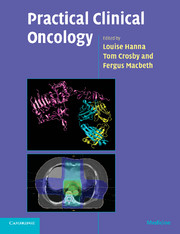Book contents
- Frontmatter
- Contents
- List of contributors
- Preface
- Acknowledgements
- Abbreviations
- 1 Practical issues in cytotoxic chemotherapy usage
- 2 Biological treatments in cancer
- 3 Hormones in cancer
- 4 Radiotherapy planning
- 5 Research in cancer
- 6 Oncological emergencies
- 7 Palliative care
- 8 Head and neck
- 9 Oesophagus
- 10 Stomach
- 11 Liver, gallbladder and biliary tract
- 12 Exocrine pancreas
- 13 Colon and rectum
- 14 Anus
- 15 Gastrointestinal stromal tumours
- 16 Breast
- 17 Kidney
- 18 Bladder
- 19 Prostate
- 20 Testis
- 21 Penis
- 22 Ovary
- 23 Body of the uterus
- 24 Cervix
- 25 Vagina
- 26 Vulva
- 27 Gestational trophoblast tumours
- 28 Lung
- 29 Mesothelioma
- 30 Soft tissue and bone tumours in adults
- 31 The lymphomas and myeloma
- 32 Central nervous system
- 33 Skin cancer other than melanoma
- 34 Melanoma
- 35 Thyroid
- 36 Neuroendocrine tumours
- 37 Cancer in children
- 38 Cancer of unknown primary
- 39 The use of radiotherapy in the treatment of benign conditions
- Multiple choice questions
- Multiple choice answers
- Index
- References
22 - Ovary
Published online by Cambridge University Press: 23 December 2009
- Frontmatter
- Contents
- List of contributors
- Preface
- Acknowledgements
- Abbreviations
- 1 Practical issues in cytotoxic chemotherapy usage
- 2 Biological treatments in cancer
- 3 Hormones in cancer
- 4 Radiotherapy planning
- 5 Research in cancer
- 6 Oncological emergencies
- 7 Palliative care
- 8 Head and neck
- 9 Oesophagus
- 10 Stomach
- 11 Liver, gallbladder and biliary tract
- 12 Exocrine pancreas
- 13 Colon and rectum
- 14 Anus
- 15 Gastrointestinal stromal tumours
- 16 Breast
- 17 Kidney
- 18 Bladder
- 19 Prostate
- 20 Testis
- 21 Penis
- 22 Ovary
- 23 Body of the uterus
- 24 Cervix
- 25 Vagina
- 26 Vulva
- 27 Gestational trophoblast tumours
- 28 Lung
- 29 Mesothelioma
- 30 Soft tissue and bone tumours in adults
- 31 The lymphomas and myeloma
- 32 Central nervous system
- 33 Skin cancer other than melanoma
- 34 Melanoma
- 35 Thyroid
- 36 Neuroendocrine tumours
- 37 Cancer in children
- 38 Cancer of unknown primary
- 39 The use of radiotherapy in the treatment of benign conditions
- Multiple choice questions
- Multiple choice answers
- Index
- References
Summary
Introduction
Ovarian cancer is the most common cause of death from gynaecological malignancy in the Western world. It has been named a ‘silent killer’ because of its lack of symptoms during early stages. Around 90% of ovarian cancers arise from the epithelium. Two-thirds of patients present late, with stage III or IV disease, with increasing abdominal symptoms including ascites. Typically, treatment depends on a combination of surgery and chemotherapy. Improvements in surgical techniques and chemotherapy agents have resulted in a modest increase in the 5-year survival over the past 30 years although, even now, two-thirds of women die from their disease.
Types of tumour affecting the ovary
The WHO classification of tumours of the ovary defines broad categories of ovarian tumours (WHO classification, 2003):
Surface epithelial-stromal tumours.
Sex cord-stromal tumours.
Germ cell tumours.
Tumours of the rete ovarii.
Miscellaneous tumours.
Lymphomas and haematopoietic tumours.
Secondary tumours.
Surface epithelial-stromal tumours are classified as benign, borderline or malignant. The subtypes are serous; mucinous; endometrioid, including malignant mixed müllerian tumour (carcinosarcoma); clear cell; transitional cell; squamous cell; mixed; and undifferentiated or unclassified.
Sex cord-stromal tumours are classified as granulosa-stromal cell tumours (including granulosa cell tumours and theca-fibroma tumours), sertoli-stromal cell tumours, sex-cord stromal tumours of mixed or unclassified cell types, and steroid cell tumours.
Germ cell tumours are classified as primitive germ cell tumours (including dysgerminoma, yolk sac tumour, and embryonal carcinoma), biphasic or triphasic teratomas (including immature teratoma and mature teratoma), and monodermal teratoma (composed of a single type of tissue and includes struma ovarii, which is composed of thyroid cells).
- Type
- Chapter
- Information
- Practical Clinical Oncology , pp. 257 - 266Publisher: Cambridge University PressPrint publication year: 2008



